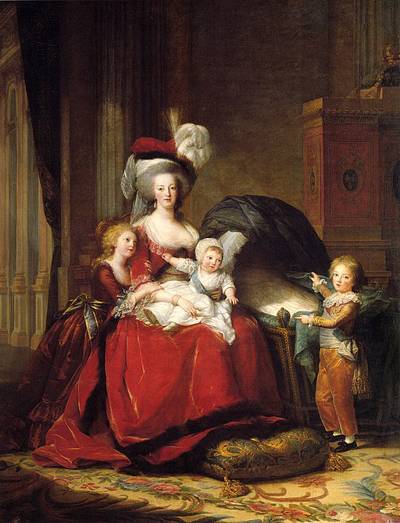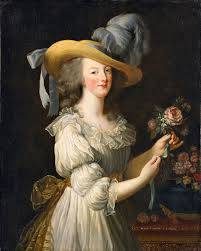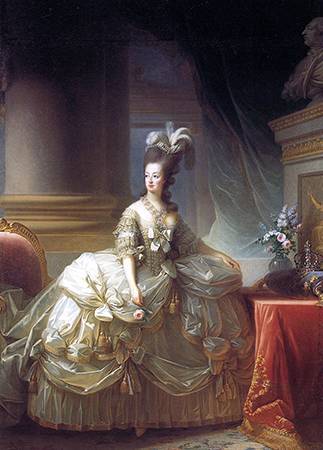From Convent to Court: Painting at the Revolution
When French portrait artist Élisabeth Vigée Le Brun painted Marie-Antoinette in 1778, and later became official royal portraitist and close friend of the queen, she could hardly have known that her neck was on the line. Literally.
The Revolution that took France by storm just over a decade after this painting was made, showing a regal royal in sumptuous hoop skirt looking haughtily to her right (and, some would say, down her nose at us) ended badly for the queen, beheaded by the very people she and her husband, King Louis XVI, presumed to rule by divine right.

Photo courtesy of BBC
As the official portraitist of Marie-Antoinette and her children in the years leading up to the French Revolution, it fell to Vigée Le Brun to create an image of the queen that would endear her to her people. (And for those who think that staged image-making and branding of a royal family are peculiarly modern skills, fit for, say a Prince and the Duchess of Windsor, take note of her skill in portraying the queen who pranced about Versailles pretending to life as a milkmaid and wearing birdcages in her elaborate hairdos.)
But the queen's official court portrait painter would later walk a tightrope.
Humble Beginnings
Her mother worked as a hairdresser. She was beautiful, and a devout Catholic and thought her daughter ugly, a fact that Vigée Le Brun's artist father remedied by indulging her with praise, and discussing his own art with her. Elisabeth spent five years in a convent school, visiting home periodically when she was in ill health. She shared her mother's devotion to her faith.
But Élisabeth was born to paint. Even in school, she kept pencils and pastels close at hand. Her father, a successful pastel portraitist, on seeing her sketch of a man with a beard done by the then-7 or 8-year-old Élisabeth, proclaimed, "You will be a painter, my child."
At 19, she married Jean-Baptiste Pierre Le Brun, then, Paris's pre-eminent art dealer. As women were barred from academic study, she taught herself artistic technique by copying the masterpieces her husband collected and sold.
Although she aspired to paint historical scenes, it was Vigée Le Brun's sympathetic portraits of aristocratic women that earned her her extraordinary reputation. She gained the attention of the queen at the age of 23, thanks to her husband's connections at the court of Versailles.
Her work avoids the showiness of the late-Rococo style popular in pre-Revolutionary France, a fashionable ideal, idealizing the idea of perpetual youth and play. It also avoids the Neo-Classical style that drew inspiration from imagery found in ancient Greek and Roman art. Naturalism—the art of making her subjects appear "naturally glamorous, or glamorously natural," in the words art historian Anne Higonnet, a professor at Barnard College. It's an Instagram approach to courtly painting.
Once Vigée Le Brun's work became known at court, she went on to earn more money than any of the male artists of her day—and, thus, the enmity of rival male painters. Unusually, for a woman of her day, she was admitted to the French Academy of Painters and Sculptors, an extraordinary honor, and rare for a woman, demonstrating mastery of her art and high regard by her peers. The recognition was thanks to her high-profile clients, the King and Queen.
On October 6, 1789, with the populace storming Versailles at the start of the French Revolution that then forced the King and Queen to take refuge in Paris, she would now become an "enemy of the people." To avoid the guillotine, she disguised herself as a maid and left the country. After fleeing to Rome, and subsequently gaining high-profile commissions in Naples, Vienna, St. Petersburg, and London, she became the first internationally-known woman artist.
Recording in her memoirs late in life, Vigée Le Brun points to what seemed, in retrospect, a prophetic statement the young girl overheard her father make to her mother, coming home, dejected, from a dinner with the noted French philosphes, Diderot and d'Alembert. "Everything that I have just learned, my dear friend, makes me believe that soon the world will be turned topsy-turvy."
After a period of success and notoriety abroad, Vigée Le Brun returned to France in 1802 when her name was struck from the list of "enemy emigrés." Unfortunately, her association with the monarchy caused her reputation to suffer then, extending into the nineteenth century. She was also accused of exploiting femininity—her own and that of her subjects—to "charm her way into influence," according to art critics of the time. In the mid-twentieth century, feminist critics scorned her for expressing scenes of maternity and love, rather than more serious subjects.
But her work has lately been celebrated in major exhibitions in Paris and New York, restoring this remarkable artist to her rightful place as a great—and prolific—painter, with more than 1,000 paintings to her credit.

Portrait of Marie Antoinette as a milkmaid
Her self-portrait shows a beautiful woman and self-assured artist.

Courtesy of Khan Academy
Want to Learn More?
- Bochicchio, Sarah. "This Painter Scandalized the 18th-Century Paris Art World with Her Smile" Artsy, 26 Sep, 2017. http://www.artsy.net/article/artsy-editorial-elisabeth-louise-vigee-le-brun-scandalized-18th-century-paris-art-smile. Accessed on 15 Mar, 2018.
- "Painting Portraits of Marie-Antoinette" RMN - Grand Palais, 17 Nov, 2015. http://www.grandpalais.fr/en/article/painting-portraits-marie-antoinette-0. Accessed on 17 Mar, 2018.
- Schofield, Hugh. "A Delayed Tribute to France's Most Famous Woman Artist" BBC News, BBC, 24 Sep, 2015. http://www.bbc.com/news/magazine-34340907. Accessed on 17 Mar, 2018.
- Smith, Roberta. "She Painted Marie Antoinette (and Escaped the Guillotine)" The New York Times, 11 Feb, 2016. http://www.nytimes.com/2016/02/12/arts/design/review-vigee-le-brun-metropolitan-museum.html. Accessed on 23 Mar, 2018.
- "Souvenirs: VIGE-LEBRUN" The Project Gutenberg EBook of Souvenirs De Madame Louise-Lizabeth Vige-Lebrun,(1/3) Par Madame Louise-Lizabeth Vige-Lebrun, 30 Nov, -0001. http://www.gutenberg.org/files/23019/23019-h/23019-h.htm. Accessed on 30 Mar, 2018.
- Dr. April Renée Lynch. "Vigée Le Brun, Self-Portrait" Khan Academy, 30 Nov, -0001. http://www.khanacademy.org/humanities/ap-art-history/later-europe-and-americas/enlightenment-revolution/a/vige-le-brun-self-portrait. Accessed on 30 Mar, 2018.